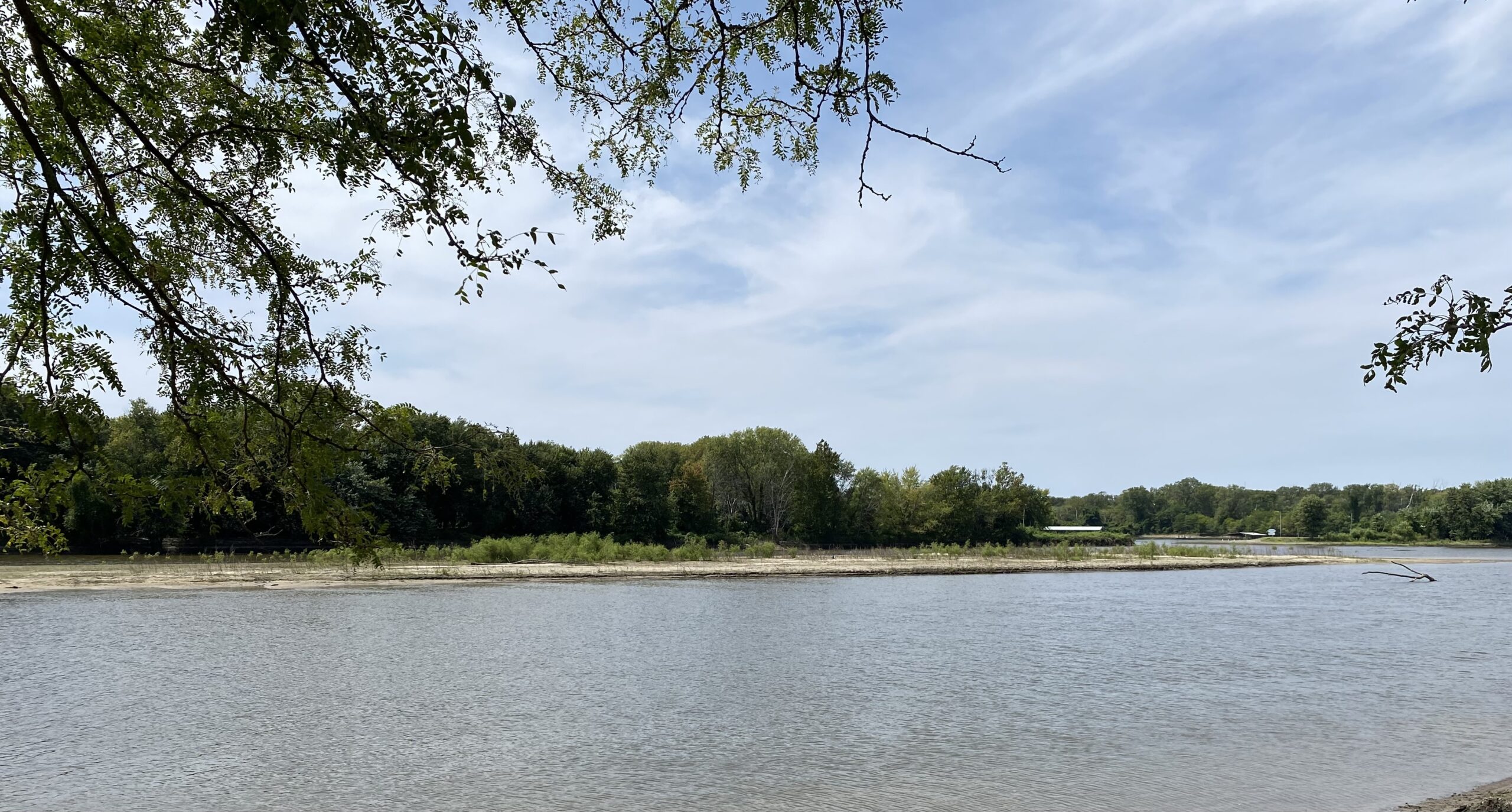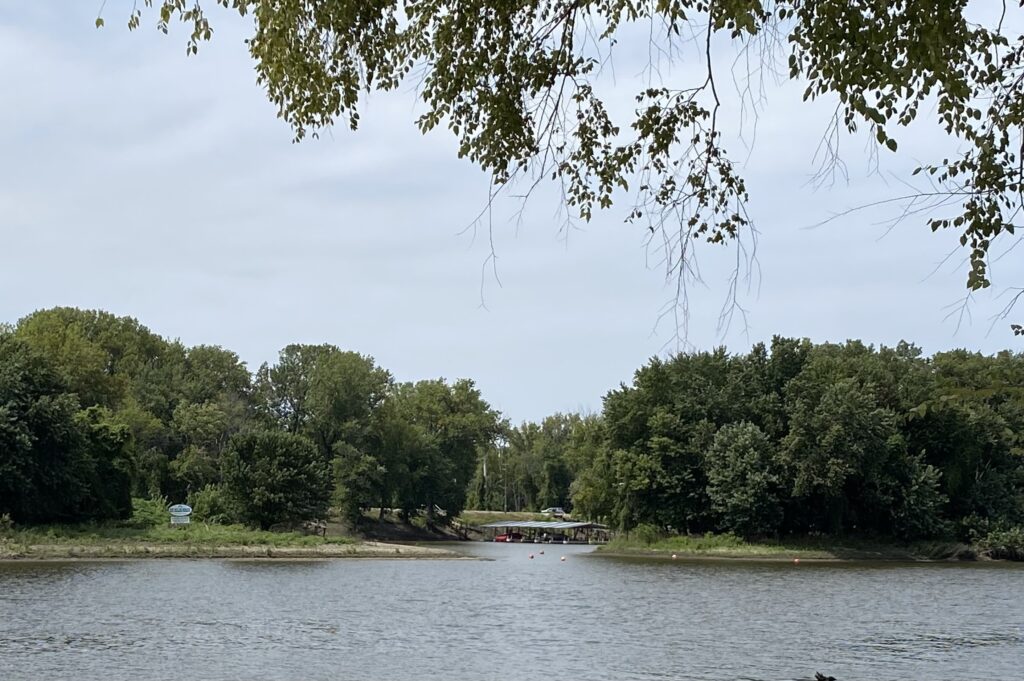Quincy riverfront to receive $3.5 million worth of dredging in 2025; $42 million habitat project unaffected

QUINCY — Quincy Bay and Quincy Harbor is receiving $3.5 million worth of dredging next year from the U.S. Army Corps of Engineers.
Six small boat harbors in the Mississippi Valley Region received funds for dredging, using $8.3 million from the Fiscal Year Energy and Water Appropriation Bill, which was signed into law by President Biden on March 9. That bill provides $8.68 billion in regular funding for the U.S. Army Corps of Engineers Civil Works Program.
Small boat harbors along the Mississippi River receiving funding next year are:
- Davenport, Iowa – $1,018,000
- Fort Madison, Iowa – $1.5 million
- Andalusia – $750,000
- Moline – $1.5 million
- Quincy Bay – $2 million
- Quincy Harbor – $1.5 million
Water levels in the Mississippi River are so low that a large island — visible from the Quincy riverfront — has formed in the middle of the river. Doug Vogel, Small Boat Harbor program manager with the Rock Island District U.S. Army Corps of Engineers, said Quincy Bay has been authorized for dredging for 9,000 feet long and 300 feet wide to a five-foot depth.
Vogel said the last time Quincy received money for small boat harbors was in 2011. He said hydraulic dredging would be the most efficient method. He’s exploring options for contracting the job or for the Corps of Engineers using its machines and staff.
In the meantime, Quincy Park District Executive Director Rome Frericks must look for a site for the spoil (a combination of sand and dirt) from the hydraulic dredging and acquire the proper permits. He said the dredging with the Quincy Bay/Quincy Harbor project is “about 10 percent” of the dredging that is planned with the restoration of Quincy Bay as part of the Habitat Rehabilitation and Enhancement Project (HREP).

The U.S. Senate Appropriations Committee gave tentative approval in August 2021 to allocate $33 million to help fully fund projects in the Upper Mississippi River Restoration (UMRR) program. The HREP, which is in Pool 21 of the Upper Mississippi River, has a $42 million price tag to revitalize more than 900 acres.
The dredging as part of the Small Boat Harbor program will buy the Quincy Park District time (and river depth) as it determines the future of the Art Keller Marina.
Boaters complained during the Aug, 14 meeting of the Quincy Park Board that the water depth in Quincy Bay was a foot and a half. Some reported several large boats recently had passed through Quincy but couldn’t refuel at the marina because of the low water depth. Commissioner John Frankenhoff asked the boaters at the meeting, with a show of hands, how many of them have had significant problems at the marina due to the shallow water. Nearly everyone raised their hand.
“This last flood, when the river was up (to 23 feet) for more than five weeks, dropped over two feet of silt on us,” Frericks said. “Without doing the modifications to the cut-through (as part of the HREP project), all that sedimentation is going to keep flowing right in once it floods again.
“The Quincy Park District could not do this ourselves because of funding and a permit (for dredging). Canton Marine Towing (which does mechanical dredging for the Park District) can’t even get up to between the Kesler Park restroom and the Dock.”
Quincy Bay has experienced severe sedimentation and land erosion that is affecting the ecosystem, including a 70 percent loss in water volume during the past 80 years. If Congress passes the spending bills and President Biden (or his successor) signs them, Quincy Bay will be dredged to 10-foot depths. A rock dam will be built to prevent further erosion from river traffic. Topological improvements, such as island elevation and wildlife habitat restoration for fish and waterfowl, would be made.
The project area for the HREP, as proposed by the Quincy Bay Area Restoration and Enhancement Association (QBAREA), starts at the bridge to Quinsippi Island and goes north to Triangle Lake. Along with dredging, QBAREA called for building a dike and weir structure at the Bay Island access channel, as well as creating above-flood elevation islands on Bay Island and northeast of Triangle Lake for reforestation and wildlife habitat restoration.
When learning earlier this month about the Small Boat Harbor funding, the first reaction from Frericks, QBAREA officials and river enthusiasts was one of concern instead of celebration.
Frericks was worried that accepting the $3.5 million in dredging could risk the loss of federal funding for the bay restoration, for which construction is scheduled to begin in 2026 and be completed by 2030.
“We were really leery about this, because we didn’t apply for this money,” Frericks said, referring to Chuck Bevelheimer, director of planning and development for the city of Quincy; Glenn Sanders, president of the Mississippi Valley Hunters and Fishermen’s Association and arguably West-Central Illinois’ strongest advocate for wildlife resources; and QBAREA chairman Mike Klingner.
That group contacted Rachel Perrine, Rock Island Plan Formulation Section Chief, Regional Planning and Environment Division with the Corps of Engineers, for an explanation.
“We didn’t want this to slow down (the HREP project) and have the Corps say, ‘Oh, we’ve got to redo the scope of work and all this because everything’s been already finalized,’” Frericks said.
“When we all spoke at the Oakley-Lindsay Center (in February), someone asked Glenn, ‘Is this the best plan?’ And he said it was. We didn’t want people to see (Small Boat Harbor) dredging without the improvements to the cut-through, because they’re going to be saying, ‘You guys are just wasting federal funding when you told us you’re going to fix the cut-through, and you haven’t done that yet. So why are you lying to us?’ That’s why we’ve had to wait a few days.”
Perrine clarified last week that the authorization and funding for the HREP project and the Quincy Bay/Quincy Harbor project are different. She also said the projects need to be coordinated as she learns more about the Small Boat Harbor dredging project, which Vogel expects to begin as early as the spring of 2025.
“We need to find out more about their anticipated dredging, the exact location, so that we can better understand how it relates to the restoration measures that we have planned,” Perrine said. “At this time, we do not see the Small Boat Harbor actions as something that will diminish or negatively impact or halt the habitat project. In fact, there are opportunities for the two programs to work in concert with one another and maximize the value of the Corps of Engineers’ work and Quincy’s local work area. We’re committed to working together to ensure the success of both the habitat project and the small boat harbor actions.”
“Since we’ve gotten this funding in the district office (in Rock Island), we have had no concern about any adverse influence on the (UMRR) project,” Vogel said. “I think we’ll be able to address the area sooner than what it would have been had we waited for the (HREP) project to start. It’s a good thing, and hopefully, we’ll execute it well, and hopefully we’ll see regular funding in the future for this.”
Miss Clipping Out Stories to Save for Later?
Click the Purchase Story button below to order a print of this story. We will print it for you on matte photo paper to keep forever.

